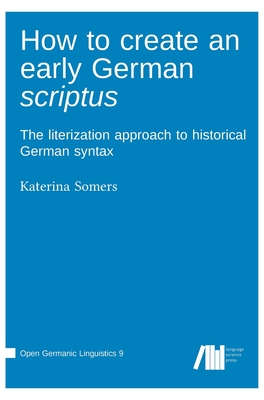
How to create an early German scriptus
Hardcover
ISBN13: 9783985541164
Publisher: Language Science Press
Published: Oct 11 2024
Pages: 288
Weight: 1.45
Height: 0.69 Width: 6.69 Depth: 9.61
Language: English
Also in
Linguistics
Arabic Stories for Language Learners: Traditional Middle Eastern Tales in Arabic and English (Online Included) [With CD (Audio)]
Mansur, Lutfi
Brosh, Hezi
Paperback
Remembering the Kanji 1: A Complete Course on How Not to Forget the Meaning and Writing of Japanese Characters
Heisig, James W.
Paperback
Korean Stories for Language Learners: Traditional Folktales in Korean and English (Free Online Audio)
Damron, Julie
You, Eunsun
Paperback
The English Grammar Workbook for Grades 6, 7, and 8: 125+ Simple Exercises to Improve Grammar, Punctuation, and Word Usage
Moss, Lauralee
Paperback
Japanese Stories for Language Learners: Bilingual Stories in Japanese and English (Online Audio Included)
Sato, Eriko
McNulty, Anne
Paperback
Historically Black Phrases: From I Ain't One of Your Lil' Friends to Who All Gon' Be There?
Anderson, Tre'vell
Hill, Jarrett
Hardcover
Quack This Way: David Foster Wallace & Bryan A. Garner Talk Language and Writing
Wallace, David Foster
Garner, Bryan
Paperback
The Perfect English Grammar Workbook: Simple Rules and Quizzes to Master Today's English
McLendon, Lisa
Paperback
Arabic Writing Workbook: Alphabet, Words, Sentences⎜Learn to write Arabic with this large and colorful handwriting workbook. For adults and kids
de Kerdoret, Soulayman
Paperback
The Only Grammar Book You'll Ever Need, Updated Edition: Your One-Stop Source for Mastering English Grammar
Thurman, Susan
Paperback
Japanese Folktales for Language Learners: Bilingual Legends and Fables in Japanese and English (Free Online Audio Recording)
Sato, Anna
Sato, Eriko
Paperback
Korean Folktales for Language Learners: Traditional Stories in English and Korean (Free Online Audio Recordings)
Killick, Andrew
Kim, Yeon-Jeong
Cho, Sukyeon
Paperback
Reading & Writing Thai: A Workbook for Self-Study: A Beginner's Guide to the Thai Alphabet and Pronunciation (Free Online Audio and Printable Flash Ca
Rattanakhemakorn, Jintana
Paperback
The Well-Spoken Thesaurus: The Most Powerful Ways to Say Everyday Words and Phrases
Heehler, Tom
Paperback
Lost in Translation: An Illustrated Compendium of Untranslatable Words from Around the World
Sanders, Ella Frances
Hardcover
Learning Japanese Hiragana and Katakana: A Workbook for Self-Study
Takagaki, Tetsuo
Henshall, Kenneth G.
Paperback
Chinese Folktales for Language Learners: Famous Folk Stories in Chinese and English (Free Online Audio Recordings)
Ling, Vivian
Wang, Peng
Paperback
A Gateway to Sindarin: A Grammar of an Elvish Language from J.R.R. Tolkien's Lord of the Rings
Salo, David
Paperback
Tuttle Practical Cambodian Dictionary: English-Cambodian Cambodian-English
Smyth, David
Kien, Tran
Paperback
The Professor and the Madman: A Tale of Murder, Insanity, and the Making of the Oxford English Dictionary
Winchester, Simon
Paperback
Shady Characters: The Secret Life of Punctuation, Symbols, and Other Typographical Marks
Houston, Keith
Paperback
Chinese Stories for Language Learners: A Treasury of Proverbs and Folktales in Bilingual Chinese and English (Online Audio Recordings Included)
Ling, Vivian
Wang, Peng
Paperback
Learn Korean - The Language Workbook for Beginners: An Easy, Step-by-Step Study Book and Writing Practice Guide for Learning How to Read, Write, and T
Polyscholar
Lee, Jennie
Paperback
Learn Japanese with Manga Volume Two: A Self-Study Language Guide (Free Online Audio)
Bernabe, Marc
Paperback
Japanese Kanji for Beginners: (Jlpt Levels N5 & N4) First Steps to Learn the Basic Japanese Characters [Includes Online Audio & Printable Flash Card
Hakone, Kaori
Stout, Timothy G.
Paperback
The Horse, the Wheel, and Language: How Bronze-Age Riders from the Eurasian Steppes Shaped the Modern World
Anthony, David W.
Paperback
Kanji Practice Sheets: Genkouyoushi Paper to Learn the Basic Japanese Characters
Blank, Thomas
Paperback
Print and Cursive Handwriting Workbook: 35 Lessons to Improve Your Penmanship
Sanders, Sally
Paperback
English Dictionary Complete and Unabridged Edition with Slipcase: More Than 732,000 Words Meanings and Phrases
Collins Dictionaries
Hardcover
Other People's English: Code-Meshing, Code-Switching, and African American Literacy
Young-Rivera, Y'Shanda
Young, Vershawn Ashanti
Barrett, Rusty
Paperback
The Code Book: The Science of Secrecy from Ancient Egypt to Quantum Cryptography
Singh, Simon
Paperback
The 1560 Defined Geneva Bible: With Modern Spelling, New Testament
Brown, David L.
Krueger, James
Hardcover
Oxford Picture Dictionary for the Content Areas Academic Language Accelerator
Apple, Gary
Kauffman, Dorothy
Hardcover
'O Faia Fa'atumua O Samoa Mai Tala O Le Vavau
Simanu, 'Aumua Mata'itusi
Papalii, Aumua Mataitusi Sima
Paperback
The Complete Guide to Japanese Kanji: (Jlpt All Levels) Remembering and Understanding the 2,136 Standard Characters
Seely, Christopher
Henshall, Kenneth G.
Paperback
Living Language Dothraki: A Conversational Language Course Based on the Hit Original HBO Series Game of Thrones [With Paperback Book]
Peterson, David J.
Paperback
Check Your English Vocabulary for TOEFL: Essential Words and Phrases to Help You Maximise Your TOEFL Score
Wyatt, Rawdon
Paperback
The Art of Language Invention: From Horse-Lords to Dark Elves to Sand Worms, the Words Behind World-Building
Peterson, David J.
Paperback
Basic Written Chinese: An Introduction to Reading and Writing for Beginners (Audio Recordings Included)
Kubler, Cornelius C.
Paperback
Chinese for Beginners: Learning Conversational Chinese (Fully Romanized and Free Online Audio)
Liang, Xiyuan
Ren, Yi
Paperback
Como hablar bien en publico e influir en los hombres de negocios por Dale Carnegie autor de Como Ganar Amigos
Carnegie, Dale
Paperback
Remembering the Kanji 2: A Systematic Guide to Reading the Japanese Characters
Heisig, James W.
Paperback
The Power of Language: How the Codes We Use to Think, Speak, and Live Transform Our Minds
Marian, Viorica
Hardcover
Japanese Kanji Made Easy: An Easy Step-By-Step Workbook to Learn the Basic Japanese Kanji (JLPT N5)
Lingo Mastery
Paperback
Learning Hindi: Speak, Read and Write Hindi with Manga Comics! a Language Guide for Self-Study (Free Online Audio & Flash Cards)
Samarth, Brajesh
Paperback
Writing Japanese Hiragana: An Introductory Japanese Language Workbook: Learn and Practice the Japanese Alphabet
Gleeson, Jim
Paperback
Vietnamese Stories for Language Learners: Traditional Folktales in Vietnamese and English (Free Online Audio)
Le, Tram
Tran, Tri C.
Paperback
Tuttle Pocket Chinese Dictionary: English-Chinese Chinese-English (Fully Romanized)
Dong, Li
Paperback
Arabic for Beginners: A Guide to Modern Standard Arabic (Free Online Audio and Printable Flash Cards)
Risha, Sarah
Paperback
Through the Language Glass: Why the World Looks Different in Other Languages
Deutscher, Guy
Paperback
Alice's Adventures in Wonderland: An Edition Printed in the Nyctographic Square Alphabet Devised by Lewis Carroll
Carroll, Lewis
Tenniel, John
Paperback
The Dictionary People: The Unsung Heroes Who Created the Oxford English Dictionary
Ogilvie, Sarah
Hardcover
Language Files: Materials for an Introduction to Language and Linguistics, 13th Edition
Linguistics, Department Of
Paperback
Learning Korean: A Language Guide for Beginners: Learn to Speak, Read and Write Korean Quickly! (Free Online Audio & Flash Cards)
Baik, Juno
Damron, Julie
Paperback
Cursive Handwriting Book: 3-in-1 Cursive Handwriting Workbook for Kids Grades 2-5 - Cursive Letter Tracing Book. Cursive Writing Practice Book t
Publications, For Kids
Paperback
Mastering Logical Fallacies: The Definitive Guide to Flawless Rhetoric and Bulletproof Logic
Withey, Michael
Paperback
Hardly Harmless Drudgery: A 500-Year Pictorial History of the Lexicographic Geniuses, Sciolists, Plagiarists, and Obsessives Who Defined the English L
Garner, Bryan A.
Lynch, Jack
Hardcover
Kingdom of Characters (Pulitzer Prize Finalist): The Language Revolution That Made China Modern
Tsu, Jing
Paperback
English Vocabulary in Use Elementary Book with Answers and Enhanced eBook: Vocabulary Reference and Practice
McCarthy, Michael
O'Dell, Felicity
Paperback
Reading and Writing Korean: A Workbook for Self-Study: A Beginner's Guide to the Hangeul Writing System (Free Online Audio and Printable Flash Cards)
Kiaer, Jieun
Driggs, Derek
Paperback
The Words You Should Know to Sound Smart: 1200 Essential Words Every Sophisticated Person Should Be Able to Use
Bly, Robert W.
Paperback
The Little Book of Lost Words: Collywobbles, Snollygosters, and 86 Other Surprisingly Useful Terms Worth Resurrecting
Gillard, Joe
Hardcover
How to Keep Your Language Alive: A Commonsense Approach to One-On-One Language Learning
Hinton, Leanne
Paperback
Arabic Folktales for Language Learners: Traditional Stories in Arabic and English (Free Bilingual Online Audio)
Risha, Sarah
Paperback
Elementary Korean Workbook: A Complete Language Activity Book for Beginners (Online Audio Included)
Lee, Insun
Paperback
Word Smart, 6th Edition: 1400+ Words That Belong in Every Savvy Student's Vocabulary
The Princeton Review
Paperback
Japanese for Beginners: Learning Conversational Japanese - Second Edition (Includes Online Audio) [With CD (Audio)]
Toyozato, Sachiko
Paperback
Basic Korean: Learn to Speak Korean in 19 Easy Lessons (Companion Online Audio and Dictionary)
Kim, Soohee
Curtis, Emily
Cho, Haewon
Paperback
A Gaelic Alphabet: a guide to the pronunciation of Gaelic letters and words
McLennan, George
Paperback
Easy Thai: A Complete Language Course and Pocket Dictionary in One! (Free Companion Online Audio)
Rattanakhemakorn, Jintana
Paperback
The Unfolding of Language: An Evolutionary Tour of Mankind's Greatest Invention
Deutscher, Guy
Paperback
Linguistics of American Sign Language, 5th Ed.: An Introduction
Mulrooney, Kristin J.
Lucas, Ceil
Valli, Clayton
Hardcover
Japanese Kanji and Kana Workbook: A Self-Study Workbook for Learning Japanese Characters
Hadamitzky, Wolfgang
Spahn, Mark
Paperback
Made in America: An Informal History of the English Language in the United States
Bryson, Bill
Paperback
The Common Core Companion: The Standards Decoded, Grades K-2: What They Say, What They Mean, How to Teach Them
Burke, Jim
Taberski, Sharon D.
Paperback
Thai Picture Dictionary: Learn 1,500 Thai Words and Phrases - The Perfect Visual Resource for Language Learners of All Ages (Includes Online Audio)
Rattanakhemakorn, Jintana
Hardcover
Calling Bullshit: The Art of Skepticism in a Data-Driven World
Bergstrom, Carl T.
West, Jevin D.
Paperback
English with an Accent: Language, Ideology, and Discrimination in the United States
McGowan, Kevin B.
Barrett, Rusty
Cramer, Jennifer
Paperback


 Sign-In
Sign-In Cart
Cart